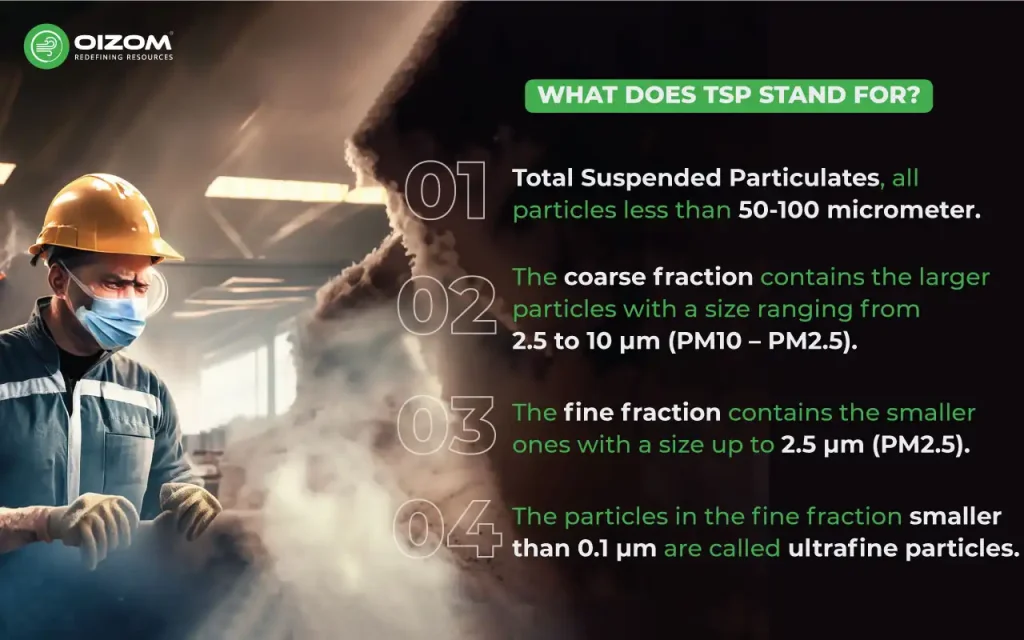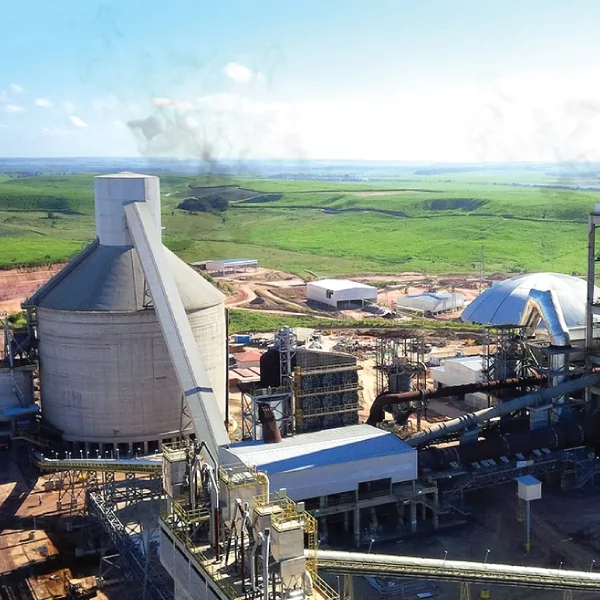We can tell when food or water is contaminated, but we don’t realise how polluted the air is because we can’t see it. We consume over 2000 gallons of air daily, almost enough to fill a normal-sized swimming pool. While more significant pollutants are visible to the naked eye, particulate matter, which is made up of tiny solid and liquid particles, is not. These dispersed particulates are 25 to 100 times finer than a human hair (which is why we can’t see them). They can enter the respiratory system, penetrate deep into the lungs, and even enter the bloodstream, causing severe health problems. This blog will provide complete information on measuring air quality and the importance of monitoring airborne dust levels.
What is total suspended particulate?
The U.S. EPA defines particulate air pollution as an air-suspended mixture of solid and liquid particles. TSP includes airborne particles > 10µm (micrometers) in diameter.
Earthworks, construction, and roads can release TSP, as well as the combustion of fuels such as wood and coal (for home heating and industries) and petrol and diesel (for automobiles). Sea salt, dust, pollen, smoke (from bushfires), and volcanic ash are all natural sources of TSP.
Particulate matter originates from both natural and human causes. Natural sources include sea salt, forest fire smoke, pollen, and mould. The following human activities are responsible for PM10 entering the atmosphere:
- Fuel-burning – both diesel and coal
- Construction sites
- Industrial emissions, such as power plants
- Vehicle exhaust
What does tsp stand for?

Total suspended particulate matter (TSP) comprises solid and liquid airborne particles with diameters less than 100 micrometres. Based on size, particulate matter is often divided into two main groups:
- TSP: Total Suspended Particulates, all particles less than 50-100 micrometer.
- The coarse fraction contains the larger particles with a size ranging from 2.5 to 10 µm (PM10 – PM2.5).
- The fine fraction contains the smaller ones with a size up to 2.5 µm (PM2.5). The particles in the fine fraction smaller than 0.1 µm are called ultrafine particles.
Sources of TSP
TSP, a complex mixture of airborne dust, soot, and small pieces, can tremendously influence our environment and health. While natural sources such as wind erosion and wildfires have a role, anthropogenic sources caused by human activity are critical players in the TSP scenario.
Anthropogenic sources
Anthropogenic activities are those that are caused or influenced by humans. Anthropogenic activities are any actions related to or resulting from the impact of humans. Sources of anthropogenic activities are Industrial activities, road traffic, power plants, residential burning (coal, wood, etc.), incineration, and resuspension of road and construction dust are significant producers of primary particles. Wet and dry deposition removes particulate materials from the atmosphere.
Industrial activities
TSP emissions from factories, mining, and building sites are significant. Crushing, grinding, and processing raw materials generate dust clouds while burning fossil fuels produces pollutants such as sulphur dioxide and nitrogen oxides, which react with water vapour to form fine particulate matter. Metal refineries, cement industries, and power plants are infamous for emitting TSP into the atmosphere.
Vehicular emissions
TSP is greatly influenced by exhaust emissions from petrol and diesel engines, which emit fine particles such as black carbon and hydrocarbons. Congestion in urban areas exacerbates the problem, causing pollution and respiratory problems. The wear and tear of tyres and brakes also contribute to the mix of airborne dust. A study conducted for the percentage contribution of different anthropogenic sources shows that traffic or automobiles contributed 34 and 37% to PM10 and PM2.5 pollution load, respectively.
Burning of fossil fuels and biomass
We rely primarily on coal, oil, and gas for electrical generation and heating. Unfortunately, the combustion of these fossil fuels emits not just greenhouse gases but also a substantial quantity of TSP. Open burning of agricultural waste and wood for cooking or heating in rural areas adds to the burden by emitting a mixture of fine particles and hazardous substances.
Agricultural practices
Tilling fields, using heavy machinery, and harvesting crops cause dust to become airborne, particularly during dry seasons. TSP is exacerbated further by wind erosion of loose soil. Furthermore, using some fertilizers and pesticides can release ammonia and other volatile compounds, which combine with other pollutants to generate secondary particulate matter.
Natural sources
Emission sources (geogenic and biogenic) include
(1) Volcanic eruptions, (2) windblown dust, including deserts and unpaved roads; (3) Forest fires.
Volcanic eruptions
Volcanoes can emit ash, particulate matter air pollution, into the air for miles downwind of the eruption. They also produce and release gases mixed with water and tiny particles that form a type of pollution called vog. Children, the elderly, and persons with lung diseases such as asthma and chronic obstructive pulmonary disease (COPD), which includes chronic bronchitis and emphysema, are especially vulnerable to volcanic ash.
Forest fires
Another natural source of TSP is wildfires. When woods burn, ash, smoke, and organic particles are sent into the sky. These particles, capable of travelling long distances, cause cloudy skies and worsened air quality far from the source of the fire. When trees and vegetation are burned, they emit particulate matter and dangerous pollutants such as carbon monoxide and volatile organic compounds. These phenomena were shown by the California wildfires in 2020, which blanketed broad areas in smoke, issued health advisories, and worsened air quality.
Windblown dust from deserts and unpaved roads
A more understated source of natural TSP is windblown dust. Arid landscapes and unpaved roads contribute to this phenomenon, as wind erosion lifts fine particles into the air, sometimes forming massive dust storms. These storms can cross continents, transporting dust across vast expanses. For instance, the Sahara Desert’s haboobs can extend to the Caribbean and even the Amazon, affecting air quality in distant regions. Such windblown dust hampers visibility and poses respiratory risks, particularly to vulnerable groups.
Tsp measurements
“Suspended particulate matter” is measured and classified in a variety of ways:
- Total Suspended Particles is the fraction captured with high-volume samplers with particle sizes ranging from < 50 to 100 µm.
- PM10: Inhalable particles with a diameter of <10 µm. By breathing through the nose, it enters the body.
- Thoracic particles: almost equal to PM10.
- PM2.5: “Fine fraction” with a diameter of <2.5 µm. It gets into the lungs.
Black smoke: a measurement of the blackness of a particle sample collected on white filter paper and translated to a mass value (µg/m3) for the particle sample using a standard curve. Provides a relative value for the sample’s soot content.
How does Oizom help to reduce the TSP?
Oizom provides fixed choices for continuous real-time TSP monitoring in outdoor environments. TSP is frequently evaluated with PM10 and PM2.5, particularly at industrial sites requiring nuisance dust evaluation and tracking.
- Advanced Monitoring Systems: Oizom provides high-end air quality monitoring equipment that accurately measures TSP levels. By detecting and quantifying TSP concentrations in the air, these systems offer crucial data for understanding the extent and sources of particulate pollution.
- Data-Driven Insights: The data collected by Oizom’s sensors generates insightful analytics. This information helps identify pollution hotspots and understand TSP distribution patterns. Such insights are essential for formulating targeted strategies to mitigate TSP pollution.
One helpful suggestion is to look for emission sources like trash fires, solid fuel burning and industrial pollution. Other pollution sources include bushfire smoke, windblown dust, and biogenic emissions from vegetation (pollen and mould spores).
Conclusion
Extensive research on the effects of Total Suspended Particulate has linked high levels of exposure to significant health problems such as premature mortality, chronic respiratory disease, emergency visits and hospital admissions, aggravated asthma, acute respiratory symptoms, and a decrease in lung function. As a result, practically all countries have strict laws to maintain safe levels of PM2.5 and PM10. However, this complex mixture includes organic and inorganic particles, such as dust, pollen, soot, smoke, and liquid droplets.






